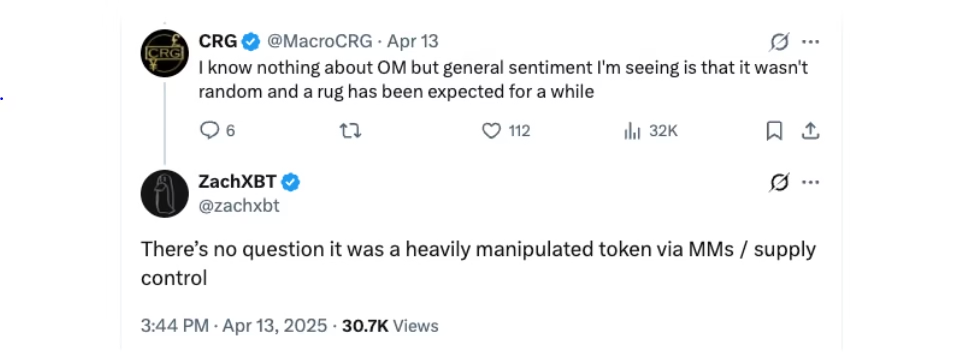
- Mantra token crash was driven by insider activity and market mismanagement, not by structural flaws like Terra Luna’s collapse.
- Despite the sharp drop, OM has shown signs of recovery, highlighting key differences between the two events.
The recent collapse of Mantra’s OM token drew immediate comparisons to the infamous Terra Luna crash of 2022. However, members of the crypto community argue that, beyond similar-looking price charts, the two events are fundamentally different.
A Visual Echo, But Different Roots
Mantra’s OM token plummeted 92% on April 13, 2025, crashing from over $6 to roughly $0.52 in just a few hours. This sharp decline erased $5.4 billion in market cap, sparking panic across social media. The steep and sudden drop resembled the Terra ecosystem’s meltdown in May 2022, when TerraClassicUSD (USTC) and LUNA collapsed. But the resemblance ends at the charts, say industry insiders.
“The two crashes might look alike on a graph, but they’re nothing alike underneath,” explained Ben Yorke, VP of ecosystem at DeFi project Woo. “Mantra’s collapse was driven by internal mismanagement and large insider token movements, not by a flawed algorithm like Terra’s.”
Terra’s Systemic Failure vs. Mantra OM’s Market Shock
Terra’s downfall stemmed from its algorithmic stablecoin UST losing its dollar peg, which led to a catastrophic death spiral. The collapse wiped out $17.2 billion over five days and left the entire system broken.
In contrast, Mantra’s issue was not protocol-based. Alexis Sirkia, chairman at Yellow Network, emphasized, “Mantra didn’t fail structurally. There was no stablecoin depegging, no algorithm breaking. It was a market-driven crash triggered by poor token management, not protocol flaws.”

Source: CoinGecko
Insider activity played a major role. According to Yorke, a large number of OM tokens held by insiders were moved to exchanges, which set off a chain reaction of liquidations. The crash eroded trust but not the technology.

Signs of Resilience and Recovery
Unlike Terra, Mantra has already shown signs of bouncing back. Just days after the crash, OM recovered over 200%, reaching $0.80. This rebound reflects ongoing community support and market interest—something Terra never saw after its collapse.
“The team has remained transparent, and the community believes in the project,” said Sirkia. A post-mortem report from Mantra is expected soon, offering more clarity on what happened and what’s next.
In summary, while Mantra’s token crash was severe, it was not a Terra-style failure. The root causes, project design, and aftermath reveal two very different stories—linked only by how they appear on a chart.
RELATED:MANTRA’s OM Token Crashes 90% Within 24 Hours Amid Allegations of Insider Manipulation
DISCLAIMER:
The views and opinions expressed herein are solely those of the author and do not necessarily reflect the views of the publisher. The publisher does not endorse or guarantee the accuracy of any information presented in this article. Readers are encouraged to conduct further research and consult additional sources before making any decisions based on the content provided.




